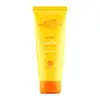What's inside
What's inside
 Key Ingredients
Key Ingredients

 Benefits
Benefits

 Concerns
Concerns

 Ingredients Side-by-side
Ingredients Side-by-side

Water
Skin ConditioningSodium Lauroyl Sarcosinate
CleansingPolyacrylate-33
Disodium Cocoamphodiacetate
CleansingCocamidopropyl Betaine
CleansingGlycerin
HumectantSodium PCA
HumectantSodium Hyaluronate
HumectantBetaine
HumectantCoco-Glucoside
CleansingGlyceryl Oleate
EmollientGuar Hydroxypropyltrimonium Chloride
Skin ConditioningPhenoxyethanol
PreservativeEthylhexylglycerin
Skin ConditioningParfum
MaskingSodium Hydroxide
BufferingHydrogenated Castor Oil
EmollientCarica Papaya Fruit Extract
Skin ConditioningSodium Benzoate
MaskingAloe Barbadensis Leaf Extract
EmollientPanthenol
Skin ConditioningSodium Ascorbyl Phosphate
AntioxidantCI 15985
Cosmetic ColorantCI 19140
Cosmetic ColorantWater, Sodium Lauroyl Sarcosinate, Polyacrylate-33, Disodium Cocoamphodiacetate, Cocamidopropyl Betaine, Glycerin, Sodium PCA, Sodium Hyaluronate, Betaine, Coco-Glucoside, Glyceryl Oleate, Guar Hydroxypropyltrimonium Chloride, Phenoxyethanol, Ethylhexylglycerin, Parfum, Sodium Hydroxide, Hydrogenated Castor Oil, Carica Papaya Fruit Extract, Sodium Benzoate, Aloe Barbadensis Leaf Extract, Panthenol, Sodium Ascorbyl Phosphate, CI 15985, CI 19140
Water
Skin ConditioningCocamidopropyl Betaine
CleansingDecyl Glucoside
CleansingGlycerin
HumectantDisodium Cocoyl Glutamate
CleansingTriethanolamine
BufferingSodium Ascorbyl Phosphate
AntioxidantCitric Acid
BufferingCitrullus Lanatus Fruit Extract
Skin ConditioningCucumis Sativus Fruit Extract
EmollientAloe Barbadensis Extract
Skin ConditioningMentha Piperita Oil
MaskingTocopheryl Acetate
AntioxidantPEG-40 Hydrogenated Castor Oil
EmulsifyingMenthol
MaskingAcrylates/C10-30 Alkyl Acrylate Crosspolymer
Emulsion StabilisingXanthan Gum
EmulsifyingPanthenol
Skin ConditioningBenzyl Alcohol
PerfumingEthylhexylglycerin
Skin ConditioningTocopherol
AntioxidantDisodium EDTA
CI 16185
Cosmetic ColorantWater, Cocamidopropyl Betaine, Decyl Glucoside, Glycerin, Disodium Cocoyl Glutamate, Triethanolamine, Sodium Ascorbyl Phosphate, Citric Acid, Citrullus Lanatus Fruit Extract, Cucumis Sativus Fruit Extract, Aloe Barbadensis Extract, Mentha Piperita Oil, Tocopheryl Acetate, PEG-40 Hydrogenated Castor Oil, Menthol, Acrylates/C10-30 Alkyl Acrylate Crosspolymer, Xanthan Gum, Panthenol, Benzyl Alcohol, Ethylhexylglycerin, Tocopherol, Disodium EDTA, CI 16185
Ingredients Explained
These ingredients are found in both products.
Ingredients higher up in an ingredient list are typically present in a larger amount.
Cocamidopropyl Betaine is a fatty acid created by mixing similar compounds in coconut oil and dimethylaminopropylamine, a compound with two amino groups.
This ingredient is a surfactant and cleanser. It helps gather the dirt, pollutants, and other impurities in your skin to be washed away. It also helps thicken a product and make the texture more creamy.
Being created from coconut oil means Cocamidopropyl Betaine is hydrating for the skin.
While Cocamidopropyl Betaine was believed to be an allergen, a study from 2012 disproved this. It found two compounds in unpure Cocamidopropyl Betaine to be the irritants: aminoamide and 3-dimethylaminopropylamine. High-grade and pure Cocamidopropyl Betaine did not induce allergic reactions during this study.
Learn more about Cocamidopropyl BetaineEthylhexylglycerin (we can't pronounce this either) is commonly used as a preservative and skin softener. It is derived from glyceryl.
You might see Ethylhexylglycerin often paired with other preservatives such as phenoxyethanol. Ethylhexylglycerin has been found to increase the effectiveness of these other preservatives.
Glycerin is already naturally found in your skin. It helps moisturize and protect your skin.
A study from 2016 found glycerin to be more effective as a humectant than AHAs and hyaluronic acid.
As a humectant, it helps the skin stay hydrated by pulling moisture to your skin. The low molecular weight of glycerin allows it to pull moisture into the deeper layers of your skin.
Hydrated skin improves your skin barrier; Your skin barrier helps protect against irritants and bacteria.
Glycerin has also been found to have antimicrobial and antiviral properties. Due to these properties, glycerin is often used in wound and burn treatments.
In cosmetics, glycerin is usually derived from plants such as soybean or palm. However, it can also be sourced from animals, such as tallow or animal fat.
This ingredient is organic, colorless, odorless, and non-toxic.
Glycerin is the name for this ingredient in American English. British English uses Glycerol/Glycerine.
Learn more about GlycerinPanthenol is a common ingredient that helps hydrate and soothe the skin. It is found naturally in our skin and hair.
There are two forms of panthenol: D and L.
D-panthenol is also known as dexpanthenol. Most cosmetics use dexpanthenol or a mixture of D and L-panthenol.
Panthenol is famous due to its ability to go deeper into the skin's layers. Using this ingredient has numerous pros (and no cons):
Like hyaluronic acid, panthenol is a humectant. Humectants are able to bind and hold large amounts of water to keep skin hydrated.
This ingredient works well for wound healing. It works by increasing tissue in the wound and helps close open wounds.
Once oxidized, panthenol converts to pantothenic acid. Panthothenic acid is found in all living cells.
This ingredient is also referred to as pro-vitamin B5.
Learn more about PanthenolSodium Ascorbyl Phosphate is a form of Vitamin C. It is the salt of ascorbic acid.
This ingredient is more gentle than ascorbic acid. It is also more stable when exposed to light and oxygen.
Vitamin C helps reduce redness, improve skin texture, reduce the effects of aging, reduce the visibility of dark spots, and brighten skin.
Your skin uses Vitamin C to produce collagen and collagen production plays a role in having a strong skin barrier and plump skin. As an antioxidant, this ingredient also helps reduce the signs of aging such as fine-lines and wrinkles.
VItamin C helps brighten skin by blocking the process of skin darkening.
In a 2011 study, Sodium Ascorbyl Phosphate was found to have antibacterial properties. This may help treat acne.
Read more about other types of Vitamin C:
Learn more about Sodium Ascorbyl PhosphateWater. It's the most common cosmetic ingredient of all. You'll usually see it at the top of ingredient lists, meaning that it makes up the largest part of the product.
So why is it so popular? Water most often acts as a solvent - this means that it helps dissolve other ingredients into the formulation.
You'll also recognize water as that liquid we all need to stay alive. If you see this, drink a glass of water. Stay hydrated!
Learn more about Water